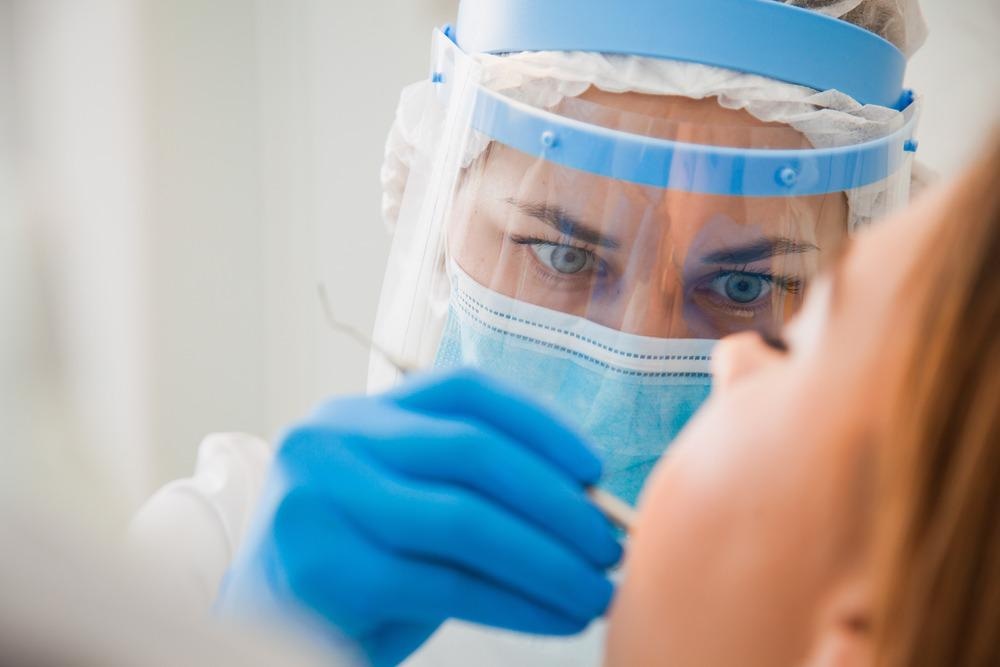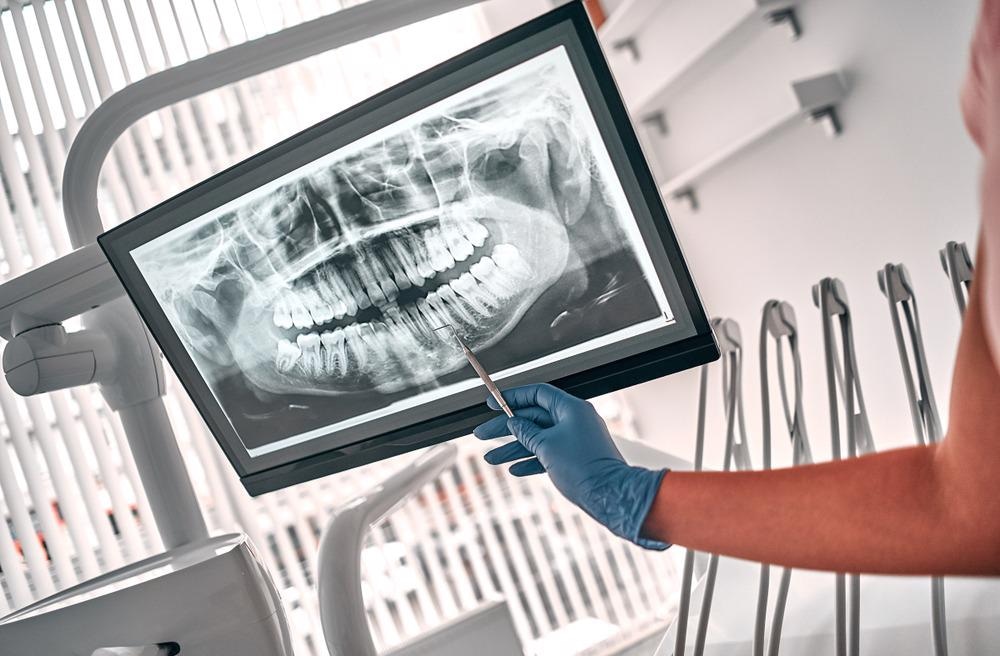Dentistry, or oral medicine, is associated with the study, prevention, diagnosis, and treatment of the conditions related to the mouth. Recently, scientists are conducting extensive research on graphene-based nanoparticles related to dentistry.

Image Credit: klyots/Shutterstock.com
A common dental condition is an oral cavity, that is often filled with dental materials. These materials remain fully in contact with gingival crevicular fluid, saliva, and water. Also, these are exposed to a high masticatory force, increased temperature, and different abrasion causing mechanical failures.
Therefore, with passing time the dental materials often require restoration or replacement. Hence, dental materials with superior properties are required for effective and durable dental procedures. Graphene nanomaterials have many unique mechanical, optical, and physiochemical properties which have been exploited in dental research recently.
Graphene and Its Unique Characteristics
Graphene is a carbon-based nanomaterial that is a 2D single-layer structure having sp2 hybridized carbon atoms, packed in a hexagonal configuration. There are different forms of graphene nanomaterials, such as few-layer graphene (FLG), ultrathin graphite, graphene oxide (GO), reduced graphene oxide (rGO), and graphene nanosheets (GNS).
These graphene nanomaterials differ from each other in terms of the number of layers, surface properties, and size.
Among the members of the graphene family nanomaterials (GFNs), GO has been used most extensively owing to its superior properties. It possesses many chemically reactive functional groups on its surface which facilitate interaction with DNA, proteins, polymers, and biomolecules.
Reduced graphene oxide (rGO) possesses heterogeneous electron-transfer properties and is derived by reducing graphene oxide via chemical, thermal, or electrochemical processes. Fluorinated graphene (FG) is another member of graphene nanomaterials that has favorable biocompatibility.
It also displays a neuroinductive effect through spontaneous cell polarization and enhances mesenchymal cell proliferation by offering a scaffold for their growth.
Graphene and Dentistry
This article highlights the potential applications of graphene in dentistry. Some of the important aspects of graphene which are applied in dentistry are discussed below.
Biocompatibility of Graphene
While developing new biomedical materials, biocompatibility is a major aspect that needs to be considered. Cytotoxicity of GFNs depends on various factors, such as morphology (size, shape, and sharp edges), dispensability, surface charge, state of aggregation, purity, methods of synthesis, number of layers, and surface functionalization.
Scientists have conducted research to determine the toxicity levels of GFNs; for example, in the case of GO, 50ug/ ml might be a toxicity threshold on normal mammalian cells. They observed that the concentration of GO above 50ug/ml had an adverse effect on human fibroblast cells and T lymphocytes.
Surface structures (e.g., wettability) also contribute to GFN’s toxicity. Typically, hydrophilic (more oxidized) graphene nanoparticles are considered to be more cytocompatible than hydrophobic graphene nanoparticles. GO is slightly hydrophilic due to the presence of oxygen-containing functional groups on its basal plane. A recent study revealed that GO showed minimal cytotoxicity and exhibited the least damage to human dental follicle stem cells.
Graphene in Tissue Engineering
One of the challenges of dental treatment is restoring missing teeth. Some of the materials used in this procedure help nurture and regenerate damaged tissue in the periodontal structure. Most available artificial biomaterials lack tissue inductive activities, which makes healings and functional reconstructions slow in many patients.
GO scaffolds, applied to tooth extraction sockets of dogs, enabled bone formation five times faster than collagen scaffolds. Interestingly, GO also exhibited non-cytotoxic reactions and accelerated the proliferation and differentiation of human mesenchymal stem cells (hMSCs) into bone cells.
Antibacterial Effect of Graphene
GFNs have been used in nanomedicine as a potential antimicrobial agent. Although the antimicrobial mechanism associated with GFNs is still in its infancy, based on several studies, three modes of action have been proposed, i.e., physical damage, photothermal ablation, and chemical effect.
In the oral cavity, the bacterium that is involved in caries formation is Streptococcus mutans and bacteria associated with periodontitis and root canal infection are Porphyromonas gingivalis and Fusobacterium nucleatum.

Image Credit: ORION PRODUCTION/Shutterstock.com
GO nanosheets are reported to be extremely effective in inhibiting the growth of all the aforementioned dental pathogens. Importantly, graphene combined with other compounds, e.g., graphene/zinc oxide nanocomposite, exhibited enhanced synergistic antimicrobial, anti-biofilm, and anti-adherence activities against oral pathogens.
Graphene in Dental Implants
During dental implantation, fibro-osseous integration occurs between the host biological system and the dental implant. A leak of the seal at the hard tissue interface or soft tissue interface may result in bacterial infection which may lead to the need to impair osteogenesis and induce bone loss.
Therefore, the healing process must be accelerated and bacterial colonization must be prevented. When graphene is coated with titanium substrate, its hydrophobic character imparts a self-cleaning effect on its surfaces, which enables a reduction in the adhesion of dental pathogens.
Further, graphene possesses an osteogenic property that increases the expression of osteogenic related genes such as RUNX2, COL-I, and ALP, and, consequently, enhances the deposition of the mineralized matrix.
Graphene in Endodontics
Root canal treatment involves cleaning an infected root canal system; however, in some cases, endodontic failure occurs due to persisting infection in the root canal. In endodontics, bioactive cement is used for the management of perforation, pulp capping, and retrograde root filling. Graphene nanosheets improve the mechanical property of the bio-cement and significantly reduce the setting time.
Graphene in Restorative Dentistry and Periodontology
Glass ionomer (GI) is commonly used in restorative dentistry. Graphene (e.g., fluoride graphene), when combined with GI, significantly enhances the mechanical, tribological, and antibacterial properties of GIs. This combined material also decreases microcracks in the internal structure and protects it from erosion and disintegration by microbial invasion.
An animal study exhibited GO scaffold’s capability in the periodontal wound healing of dogs with class II furcation defects.
References and Further Reading
Bansode, V.P. et al. (2020) GRAPHENE: A Future Promising Biomaterial In Endodontics & Restorative Dentistry: A Review. IOSR Journal of Dental and Medical Sciences. 19 (4). pp. 21-24 https://www.iosrjournals.org/iosr-jdms/papers/Vol19-issue4/Series-3/E1904032124.pdf
Nizami, I.Z.M. et al. (2020) Graphene oxide: A new direction in dentistry. Applied Materialstoday. 19, 100576. https://doi.org/10.1016/j.apmt.2020.100576
Ge, Z. et al. (2018) Graphene Family Nanomaterials: Properties and Potential Applications in Dentistry. International Journal of Biomaterials. 1539678. pp. 12. https://doi.org/10.1155/2018/1539678
Malik, S. et al. (2018) Graphene composites with dental and biomedical applicability. Beilstein journal of nanotechnology. 9. pp. 801–808. https://doi.org/10.3762/bjnano.9.7
Disclaimer: The views expressed here are those of the author expressed in their private capacity and do not necessarily represent the views of AZoM.com Limited T/A AZoNetwork the owner and operator of this website. This disclaimer forms part of the Terms and conditions of use of this website.